Your trade show exhibit is like a billboard
There are a lot of similarities between a trade show exhibit and outdoor advertising. You are located on a pathway and people are racing by. They glance to the left and to the right. They have a lot of other things to look at. You only have a few moments to attract their attention. 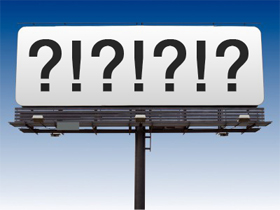 The challenge is very similar to designing a billboard to be placed on a busy Interstate highway.
The challenge is very similar to designing a billboard to be placed on a busy Interstate highway.
The best billboards evoke an emotional connection.
They are usually entertaining and often use humor. To be effective billboards must be short, sweet, simple and to the point. Not surprisingly, many of the “rules” for great outdoor advertising design translate to the trade show floor.
- Be relevant or your exhibit will be invisible. Make sure your ads appeal to your target market. Use colors, images and words that will attract them and draw prospects into your exhibit.
- Bright and bold colors are more effective. Bright colors work well, but limit your pallet to two or three at most. Exhibits with multiple bright colors are visually confusing and that reduces the overall effectiveness. Even if you are marketing natural and “green” products, consider using clean blue or bright white rather than the more expected green-brown palette. Green and brown are very likely to recede into the background and have little visual impact unless you compensate for the color palette with other design elements.
- Visibility matters. Make your major exhibit graphics large enough to be seen quickly and from a far distance.
- Use words sparingly and make them easy to read. Use large, legible type. The best bet is solid backgrounds with sharply contrasting type. And unless there is a compelling reason for vertical type, orient your type horizontally – it is easier to read.
- Choose graphics that connect with your target. Select images that will generate the strongest emotion related to your product or service.
The Low Down on Trade Show Exhibit Layouts
There are ins and outs and pros and cons to all the various types of trade show booth layouts, and determining which layout will deliver the best results for your company can be a difficult task. Evaluating your company’s needs and objectives will be your first step in determining which exhibit floor plans will work best for you.
 Let’s take a quick look at some of the more popular tradeshow exhibit layouts and the pros and cons of each to make that decision easier. Keep in mind, however, that variables exist between each layout type. Exhibitors can change each layout’s components, size, and positioning and mix and match layouts and elements to suit different situations.
Let’s take a quick look at some of the more popular tradeshow exhibit layouts and the pros and cons of each to make that decision easier. Keep in mind, however, that variables exist between each layout type. Exhibitors can change each layout’s components, size, and positioning and mix and match layouts and elements to suit different situations.
Classic Diamond.
Consists of a large, central structure with a series of independent elements (kiosks, demo stations, graphics, product displays) surrounding it.
Pros: This layout offers a strong visual presence, and its simplicity and lack of walls helps draw in visitors. Also works well for displaying multiple small products.
Cons: The layout’s central structure blocks view across the booth and offers only one spot for a single, high-impact statement or slogan. As far as traffic, this layout requires careful staffing to encourage visitors to explore the whole booth.
Centerpiece.
Typically used when one message or product needs to be featured; all other elements are directed toward one main focal point.
Pros: This layout offers easy access to focal point of booth and offers great impact for main marketing message or slogan. Allows easy access to main focus of booth.
Cons: This layout type offers little flexibility over time and single focus makes it hard to hold attendees’ interest for very long. Central focus of exhibit can attract so much traffic to cause congestion.
Theater.
The underlying purpose of this layout is to show some form of a presentation. Rather than walls, it uses dividers along the sides and demo stations or kiosks along the back.
Pros: Layout drives all attention toward presentation and openness encourages visitors who shun enclosed presentations. Allows strong medium for message delivery and partitions can display smaller, tangent messages.
Cons: Singular focus prevents highlighting multiple products. Offers no capture effect and quick exits after presentations difficult to prevent.
Club.
Also referred to as a closed exhibit, this layout type uses some type of material to create a fully or semi-enclosed environment within the booth space.
Pros: Interior offers quiet off-floor environment and exterior walls can attract attention and deliver messaging. Allows complete control over entry and exit of visitors. Exhibit walls offer lots of space for graphics.
Cons: Attendees can’t see main focus until they step inside and limited entrances discourage walk-up traffic. Main entrance clogs easily and confusion can result from too many messages.
Random Display.
This layout deconstructs formal floor plans in an effort to look unique and consists of an arbitrary arrangement of shapes, activities and elements.
Pros: Allows use of multiple products and presentation media. Permits many levels of messaging.
Cons: Prevents highlighting one central focus and multiple messages can cause chaos that work against proper message delivery. Confusing layout can be difficult to navigate and traffic can clog at focal point.
Plaza.
All large structures are pushed to the aisles to create an open, inviting environment in the center for casual conversation and product displays.
Pros: Offers open and inviting interior space that allows all elements to be seen at once. Openness encourages attendees to wander and explore; visitors are free to leave as easily as they enter. Allows placement of large graphic displays.
Cons: Doesn’t offer one main focal point. Central elements can draw too much traffic, causing congestion.
Trade Show Exhibit Design: It pays to “Think Big”
If you want a Trade Show exhibit that is memorable and persuasively communicates your brand, keep it focused on one overarching idea. Think Big. Create a “Big Idea”.
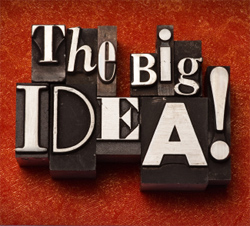 When a prospect walks into a Trade Show they are confronted with hundreds – even thousands of different marketing messages. If you are lucky, your company will have 15, maybe even 30-seconds to capture that prospect’s attention.
When a prospect walks into a Trade Show they are confronted with hundreds – even thousands of different marketing messages. If you are lucky, your company will have 15, maybe even 30-seconds to capture that prospect’s attention.
The less you try to say, the more people remember.
One way to break through the competitive clutter is to have a single-minded message – a simple statement that sums up the most important thing you can say about your company that will convince a prospect to consider buying your product – and then to communicate this message with creative that is attention-getting and memorable. This is often referred to as a “Big Idea”.
What if your company doesn’t have a single-minded message?
Sometimes the answer is already part of your company’s marketing program. For most companies, particularly B2B firms, I have found that there is no single-minded message in the advertising and marketing communications. Usually, there is a well thought out graphics standard, a nice logo and tagline, and some positioning and benefits copy on collateral and the company’s website.
If your company doesn’t have a single-minded message, develop it. Look for a key insight about your brand. Start with your customers’ buying behavior to discover one significant reason why customers buy – or why they don’t buy – from your company.
Then answer this “simple” question, “What is the one thing we want to say to our target customer to convince them to buy from us?”
Ask the people who work with you the question. Sometimes the head of Sales and Marketing can answer the question immediately. But if no one can answer the question, answer these three questions:
- Why do you need a big idea?
- What is the problem you are trying to solve?
- Why does the problem exist?
Then sum up the answers into a one sentence response that answers the question, “What is the one thing we want to say to our target customer to convince them to buy from us?”
How can you come up with a “Big Idea”?
Once you have a single-minded message, you can start to work with your creative team to create a “Big Idea” that powerfully communicates the message. A good place to start is to select an exhibit marketing support firm that has the capability of working with you to craft this “Big Idea” and to align every aspect of your trade show effort to support the “Big Idea”.
Communicate this “Big Idea” in every element of your trade show exhibit – from the graphics and exhibit to the people who are staffing your booth to promotional materials – make sure that everything is building an attention-getting, memorable message.
You can incorporate your “Big Idea” into all the elements of your trade show program:
- Exhibit theme
- Live presentations
- Traffic building attractions
- Booth staff
- Pre-show promotion
- Lead response and follow-up
Does your company have a single-minded message? Has your exhibit marketing support firm delivered a big idea for your company?
Trade Show Exhibit Design Secrets: The Star of the Show
Your trade show exhibit should be designed to focus on your products, not your display. This doesn’t mean that the graphics need to be subdued or your booth needs to be boring. It means that the graphics, colors and lighting should be integrated to draw attention to your product.
Make your products the star of your trade show display
Don’t be afraid to be bold. Use high-impact colors that will stand out at a distance. A bland  color palette will blend into the background and not draw attention or focus the audience on your product.
color palette will blend into the background and not draw attention or focus the audience on your product.
Be brand-true. You should support and build on your brand campaign. But your exhibit also needs to go beyond the brand message and convey what your company is about.
Use exhibit graphics to draw in high-potential prospects for your product. People can “read” images faster than they can read words. Use images to clearly define what your company does and to attract your target customers. Images are also an effective way to filter out people who are not likely buyers so that they do not take up your staff’s valuable trade show time.
Limit your product display to focus on signature products. No matter how large your trade show exhibit space is, it is easy to dilute the overall impact of your display with visual clutter from too many products. If you want to tell an assortment story, organize your products into groups. Trade show attendees are most interested in new products and your most important products. You can use collateral materials or electronic product directors to provide information on your full product offering.
Use lighting to spotlight what is important. Lighting can accentuate the most important information and make your products stand out. Be creative in how you use lighting to draw attention to your products. Backlighting graphics, for example, can increase initial awareness and recall of your exhibit.
The design of your trade show display can draw attention to your product. The right graphics, colors, and lighting can grab the attention of your best prospects and make your trade show exhibit a true product showcase.
Trade Show Design Trends: Multi-Purpose Custom Design
Most companies end up purchasing several kinds of displays to work for different types of events. 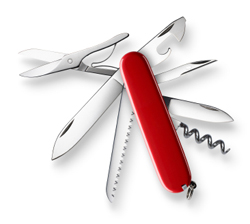 For small, local shows they have tabletop and standing displays, table covers in various sizes, and portable trade show stands. For larger spaces, they have modular displays. And for their “big show” they have a custom exhibit.
For small, local shows they have tabletop and standing displays, table covers in various sizes, and portable trade show stands. For larger spaces, they have modular displays. And for their “big show” they have a custom exhibit.
Now, some companies are asking a lot more from their trade show design firm. They want to invest in trade show exhibits that can be used for many types of events, will hold up to a lot of uses but still look new, and that can be easily updated for new shows. They are commissioning Multi-Purpose Custom Exhibits.
These companies are investing in large custom exhibits that are composed of components that can be used in smaller booths. In some cases, it is as simple as cleverly designing a large backwall so that a 10-foot section can be used in a small booth. In others, an elaborate custom space with stages, interactive displays, meeting area and merchandise fixtures is created for a large island booth at a major trade show. After the show, many of the components can be reconfigured to use for smaller exhibits.
Multi-Purpose Custom Design has financial benefits
The main motivation for moving to Multi-Purpose Custom Design is financial. Sometimes the initial custom display is a bit more expensive but most companies experience savings in the first year.
Brand consistency across all shows
Because all of the components for trade show displays are done at the same time, it is easier to maintain brand integrity. There is consistency in graphics, colors, copy positioning, and product displays.
How to start work on a Multi-Purpose Custom Design
Put together a list of all the shows on your Trade Show schedule along with planned booth sizes. Make sure to gather any special exhibit requirements. Determine how long the exhibit will be used. Is it for a year, or for longer? Define your marketing goals and how the exhibit will be tied into your company’s overarching brand campaign. Then select a custom design firm that understands how to create Multi-Purpose Custom Exhibits.
Yes, it takes a bit more planning in the beginning but the benefits are worth the effort.
Create Exhibits with Curb Appeal
Trade shows are by nature quite chaotic. Attendees bustling from booth to booth while exhibitors fight to garner their attention and interest in their companies’ products or services. Studies have shown that a tradeshow display typically has about three seconds to catch the attention and communicate to a potential customer passing by a booth. To makes things even harder, your booth is competing with possibly hundreds of other displays for attendees’ attention.
 So, exhibitors have a matter of seconds to grab attendees’ and potential prospects’ attention and make an immediate impression. Eye-popping, colorful graphics in tradeshow booths are an excellent way to do just that. Graphics in tradeshow booths can include booth signs, displays, banner stands, and even table cloths. So what makes one booth an attention-grabber and another one that’s easily passed by?
So, exhibitors have a matter of seconds to grab attendees’ and potential prospects’ attention and make an immediate impression. Eye-popping, colorful graphics in tradeshow booths are an excellent way to do just that. Graphics in tradeshow booths can include booth signs, displays, banner stands, and even table cloths. So what makes one booth an attention-grabber and another one that’s easily passed by?
Here are some things to think about when you set about creating the graphics that will hopefully deliver a powerful visual punch and grab the attention of potential prospects.
Pick a good color. The right color can help you both convey a message and stand out amidst the sea of competing booths. Warmer colors, such as red, orange and yellow attract more attention than cooler colors, such as blue, green and white.
Keep images simple. Simple, bold and clear images are the most effective in conveying your marketing message to attendees. The more ornate and involved the graphics, the more you risk confusing, overwhelming and distracting booth visitors. If possible, choose just one simple image.
Headlines are key. So put a lot of thought into writing them! Choose your words very carefully and keep it simple, clear and short. This might be the only shot at grabbing the attention of attendees who are giving your booth at most a passing glance. A crafty, compelling headline may be what brings them in to hear more about your company. Also the shorter the headline, the bigger it can be, increasing visibility.
Keep it light. Lighting is very important to helping draw the attention of attendees and in creating a welcoming atmosphere. Be creative with lighting; choose to spotlight a new product or use warmer lighting to create an inviting environment.
Choose a message that packs a punch. This is a tough one. You already know you have to keep it short and sweet with simple imagery. The things that you must communicate are: who you are, what your business does, and what separates you from your competition.
Design for Success: Branded Trade Show Booths Generate Sales
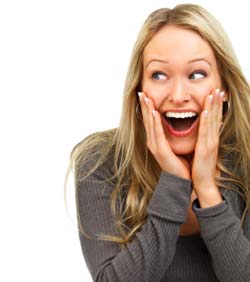 A trade show exhibit is a rare opportunity to surround your key prospects with your brand experience. An exhibit is not an impersonal 2-D experience like a TV commercial. It is not virtual and passively interactive like your company website. An exhibit can be a real 360-degree brand experience, alive with people and almost completely in your control.
A trade show exhibit is a rare opportunity to surround your key prospects with your brand experience. An exhibit is not an impersonal 2-D experience like a TV commercial. It is not virtual and passively interactive like your company website. An exhibit can be a real 360-degree brand experience, alive with people and almost completely in your control.
When you invite key prospects into a 360-degree brand experience, your booth has a chance to be one of those few memorable moments from the entire show. And the exhibitors who create these memorable moments are almost always the show sales leaders.
Be true to your brand position and personality.
Make sure that you start out with a platform that is consistent with your brand position and personality. If you are a technology company, you can be playful and use a comic book superhero theme. On the other hand, the same theme is probably not appropriate for a health care benefits company who needs to establish credibility and trust. Similarly, if your company manufactures euro-design furniture, your booth can be sleek, experimental and minimalistic. But if your company makes traditional American style furniture with a focus on fine craftsmanship, your booth design should reflect that heritage.
“Surprise and Delight” your target customers.
To create a memorable moment with your booth, you need an overarching theme and concept that will surprise and delight your target customers. You are looking for something that will break out of the endless sea of logos, photos of smiling customers, and product images. Based on surveys of trade show attendees and exhibitors, the memorable booths are not the biggest booths, they are the ones that had one big idea and focused on it.
I can’t give you a list of foolproof big ideas. You’ll need to work with your team and exhibit design company to create the concept. I can pass on one secret – get your internal and external team members to think only about your brand and what would really “Surprise and Delight” your target customers. Don’t be distracted by what your competition did last year or even what your company did last year. Brainstorm first, then evaluate the ideas once you have a list.
Once you have a concept, everything else will fall into place.
One unifying concept will pull everything together. If you have multiple products or divisions involved with the show, use the concept to unify everything. Make sure every aspect of the entire exhibit – accessories, product displays, signage and lighting – builds on the big idea.
And never forget: when it comes to a great trade show exhibit, less is more really applies. Focus relentlessly on your brand and your concept.
Trade Show Exhibit Design: Tension Fabric Displays
Tension fabric displays have many advantages; they are portable, easy to set up, affordable and inexpensive to update. Many exhibitors have switched to fabric graphics because they eliminate the possibility of glare or scratched, marred finishes. Other exhibitors appreciated the contemporary look that can be achieved with fabric graphics. With all the advantages of using tension fabric, it is no wonder that it has rapidly become commonplace. Unfortunately, commonplace can also become boring on a trade show floor.
Designers get creative with Tension Fabric
The typical tension fabric display is constructed of anodized aluminum tubing covered with a stretch fabric that has been printed with graphics. Most often, the exhibits using tension fabric basically replicate traditional trade show display forms. But now, a few exhibit designers are starting to explore the real potential of lightweight framing, tension fabric, programmed lighting and new printing technology to create some innovative new trade show exhibits that were not possible with traditional materials.
Lightweight framing offers new design freedom
The advent of lightweight aluminum framing means that designers can more freely incorporate tall structures and ceiling-hung elements in booths to increase visibility. It also has enabled designers to cost-efficiently create new freeform shapes and elegant, curved structures. These materials offer almost endless shape and size possibilities. Some designers have even created soaring three-dimensional structures that attendees can enter and be immersed in the brand experience.
Fabric graphics offer versatility
 Fabric graphics offer more versatility than laminated panels, and can be produced in varying textures and opacities. Fabrics can be used to add movement and elegance to banners, and hanging elements. And translucent fabrics printed with opaque ink and illuminated with backlighting can be used to add more dimension to the design.
Fabric graphics offer more versatility than laminated panels, and can be produced in varying textures and opacities. Fabrics can be used to add movement and elegance to banners, and hanging elements. And translucent fabrics printed with opaque ink and illuminated with backlighting can be used to add more dimension to the design.
Graphics can be printed on fabric with either a dye sublimation process or a direct ink jet printing process to achieve different effects. Dye sublimation is a continuous-tone printing technology that very closely replicates a chemical photograph and is the best way to reproduce photographs.
Direct ink jet printing produces sharper, brilliant images and is the best choice for highly graphic images. And, with recent advances in high-resolution ink jet technology, high-quality photographic images can be produced with inkjet printing. This printing method can be used on both synthetic and natural fabrics, and allows designers to create fabric graphics on silk, cotton and fabric blends.
Limitless design possibilities
Fabric is a durable, lightweight, versatile, and affordable medium for trade show exhibit design. It provides designers with countless ways to create fresh and up-to-date displays that can make a trade show exhibit stand out at even the most competitive show.
DOs and DON’Ts for Effective Trade Show Booths
So in the past few weeks we’ve talked about a myriad of trade show topics: how to entertain attendees, how to develop an effective trade show marketing strategy, tips on how to work your booth, how to reduce costs, and ways to plan before leaving for your trade show. Let’s take a few steps back and determine what are a few of the DOs and DON’Ts of pulling together a successful, enticing tradeshow exhibit.
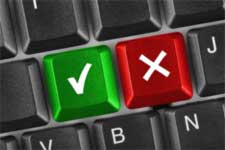 Preparing for a trade show, especially for small companies, can be a daunting task. Deciding what to include and how to set up an actual exhibit/display is one of the fundamental decisions you’ll have to make. First step is to contact the show managers and find out the size of the booth you will have, whether there is a wall space for your company sign, if there are electrical outlets available, and any other small items that you might be responsible for supplying.
Preparing for a trade show, especially for small companies, can be a daunting task. Deciding what to include and how to set up an actual exhibit/display is one of the fundamental decisions you’ll have to make. First step is to contact the show managers and find out the size of the booth you will have, whether there is a wall space for your company sign, if there are electrical outlets available, and any other small items that you might be responsible for supplying.
Here are a few other tips to keep in mind when creating your exhibit:
DON’T overstuff it. Product managers might want to display things that represent every brand or product your company offers. Partners might want their logo splashed all over your booth. Keep in mind that sometimes simpler is better. Booths overcrowded with displays, products, stands, etc., turn off prospective attendees and prevent you from quickly communicating why attendees should visit you.
DO simplify your message. Many exhibitors make the mistake of bombarding their booth visitors with marketing slogans. Instead choose the one core message you want to impart to potential customers and stick to that in terms of graphic presentations. Displaying fewer, but larger visual elements in your exhibit will reduce clutter and better garner an attendee’s attention and create a lasting impression.
DO focus on the cream of the crop. Instead of hauling your entire product line to a tradeshow booth and again cluttering your display, overwhelming visitors, and diluting your marketing message, showcase only your new and top-selling products.
DON’T rely on static displays. Any type of motion captures people’s attention as opposed to static displays. You can take advantage of this by playing a looping DVD on a widescreen TV or make use of a rotating display.
DO maintain a small, private area. If your booth is big enough, it’s nice to have a quiet, private area with a table and a few chairs to take attendees or promising prospects that might like to sit down and discuss your company and its product and services in more detail.
DON’T scrimp on carpet. This might sound silly, but after a long day of walking miles and miles on the unforgiving floors of huge exhibit halls, visitors will appreciate booths that have plush, padded carpet. And, so will your booth workers.
Trade Show Exhibit Design: The Creative Brief
When you need to have a new trade show exhibit created, plan to discuss your schedule, budget, exhibit space, how frequently the booth will be used, and if there are any special requirements for the exhibit. If you want to create a breakthrough exhibit, also take the time to put together your creative requirements.
 Even some of my most organized clients rarely organize and formalize their creative requirements before they start working on a new trade show exhibit. They generally start by providing some basic verbal instructions about the design requirements. Then spend a lot of time gathering information in response to questions from the creative team.
Even some of my most organized clients rarely organize and formalize their creative requirements before they start working on a new trade show exhibit. They generally start by providing some basic verbal instructions about the design requirements. Then spend a lot of time gathering information in response to questions from the creative team.
Letting your vendor work solely from verbal input is the best way to waste time and money. Sometimes it results in a flashy but generic exhibit, and communications disconnects. On the other hand, if you work with your design firm to create a formal creative brief, you are well on your way to creating an exhibit that fully represents your brand and engages your target customer, and makes you look like a pro.
Look for a partner who will collaborate with you and create a formal brief – a succinct statement of what you are trying to accomplish and communicate with your new trade show exhibit. Once you have a formal brief, it’s easy to run it by key stakeholders and make sure that you are on the right track. It also serves as a guide for the creative team so that they clearly understand their mission.
Most of what you need to provide is probably readily available. A few phone calls or quick visits with co-workers and you will have most of the answers. The format that you use really doesn’t matter. Just gather the answers to the key questions and work with your exhibit marketing company to create a brief.
Here’s a list of preliminary questions that I have found are a useful starting point:
Brand and Company Mission:
What is your brand position?
What is your corporate mission?
These are usually brief formal statements that are prepared by the Marketing Department.
Background:
What do you want to achieve with the exhibit?
How will you measure the success of your trade show effort?
What’s going on in the market? Any opportunities or problems in the market?
Your Target Customer:
Who is your target customer?
What should be avoided in talking to this audience?
What do they believe about your company before we tell them anything?
Is there an important secondary audience?
The Message:
If you could get one sentence through all the clutter, what would that be?
If they asked you to prove it, how would you do that?
Are there any other major points do you want to communicate?
Be critical and honest about the answers to these questions. It is great to focus on your company’s strengths but it is also important to make sure the creative team knows your company’s weaknesses and challenges.
Once you have the answers, work with your exhibit design firm to develop a creative brief that provides a clear statement of expectations and lay out a clear framework for the creative team. I have found that the most effective creative briefs result from a collaboration between the client and their design team.
Do you have a collaborative relationship with your trade show exhibit design firm? Do you think it matters?
Archives
- July 2021
- June 2021
- May 2021
- April 2021
- October 2018
- September 2018
- August 2018
- July 2018
- June 2018
- May 2018
- April 2018
- March 2018
- February 2018
- January 2018
- December 2017
- November 2017
- October 2017
- September 2017
- August 2017
- July 2017
- June 2017
- May 2017
- April 2017
- March 2017
- February 2017
- January 2017
- December 2016
- November 2016
- October 2016
- September 2016
- August 2016
- July 2016
- June 2016
- May 2016
- April 2016
- March 2016
